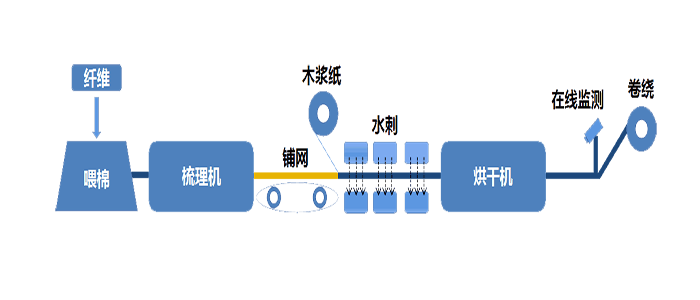spunlace fabrics are widely used in a variety of fields such as medical, filtration, household and so on due to their unique process and superior performance. As an important nonwovens production technology, the manufacturing process of spunlace fabrics involves a number of complex steps, and each step is critical, directly affecting the quality of the final product. In this article, we will provide you with a detailed analysis of the hydroentanglement process, so that you can fully understand this innovative production technology.
1. What is Hydroentanglement?
spunlace fabrics are non-woven fabrics processed by hydroentangling technology and are usually made from natural or synthetic fibres. The main characteristics of spunlace fabrics are high strength, good breathability and comfort, and they are widely used in medical, filtration, apparel and cleaning applications. Its production process is more environmentally friendly than the traditional weaving process and can provide higher production efficiency.
2. Hydroentangled fabric process overview
Hydroentanglement is a process whereby fibres are interwoven with each other by means of a high-pressure water stream to form a fabric with high strength. The process typically consists of the following key steps:
Feed
Fibres in different ratios are fed into the machine in preparation for subsequent processing.
Opening
A high power blower is used to blow the fibre clusters apart, making the fibres looser for subsequent processing.
Carding
In a carding machine, fibres are carded into a more orderly arrangement to enhance intertwining and interweaving between fibres.
Hydroentangle
The fibres are arranged in an orderly manner to form a strong hydroentangled fabric by puncturing and interweaving them under the action of a high-pressure stream of water.
Drying
The hydroentangled fabric contains moisture, which is removed by drying equipment to make the fabric dry and tough.
Winding
The dried spunlace is wound into large rolls for easy storage and transport.
Slitting
The spunlace is cut into specific sizes according to the width required by the customer to meet the needs of different applications.
3. Advantages of Hydroentangled Fabric Process
Hydroentangled fabric process has many unique advantages over the traditional weaving or knitting process:
Efficient and environmentally friendly
Hydroentanglement technology does not require the use of adhesives, so the entire production process is more environmentally friendly and does not produce chemicals that are harmful to the human body or the environment. In addition, the hydroentangled fabric production process consumes less energy, resulting in high overall productivity.
Good Performance
Hydroentangled fabrics offer high strength, abrasion resistance and tear resistance, while retaining softness and comfort for a variety of application scenarios, especially in the medical and personal care fields.
Versatile functionality
Through different post-treatment processes, hydroentangled fabrics can be equipped with a variety of additional functions, such as anti-bacterial, anti-static, and high water absorbency, to meet the needs of different users.
Cost Advantage
Due to the simplicity and high efficiency of the production process, the production cost of hydroentangled fabrics is relatively low, which is especially suitable for mass production. This makes hydroentangled fabrics have strong price competitiveness in the market.
4. Application areas of spunlace fabrics
Hydroentangled fabrics are used in a wide range of industries due to their excellent properties.Common applications include:
Medical industry: Hydroentangled fabrics can be used to produce disposable surgical gowns, isolation gowns, cleaning cloths, etc. Due to its high strength, breathability and anti-bacterial properties, it can provide effective protection for medical personnel.
Household products: Hydroentangled fabrics can be used to produce highly absorbent bedding, cleaning cloths, etc. Because of its softness and comfort, it is very suitable for daily use in the family.
Automotive: Hydroentangled fabrics are also commonly used in automotive seats and interior finishes to extend the service life of automotive interior materials due to their durability and tear resistance.
Environmentally friendly products: Due to its recyclable and environmentally friendly characteristics, spunlace is also often used in the production of eco-friendly bags, filtration materials and so on.
5. Conclusion
The hydroentanglement process not only improves the production efficiency of nonwovens, but also makes the products reach an excellent level in terms of strength, breathability and comfort.Whether in the medical, household or industrial fields, hydroentangled fabrics have become one of the important raw materials in the market by virtue of their environmentally friendly, economical and high-performance features. If you are interested in the production process of hydroentangled fabrics or have related needs, please feel free to contact us, we will provide you with detailed technical support and solutions.

